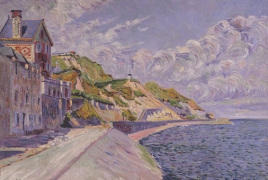
This spring, the Musée Jacquemart-André is presenting an ensemble of some fifty or so prestigious artworks—from both private collections and major American and European museums—that retrace the history of Impressionism, from the forefathers of the movement to the Great Masters, Art Daily reports.
The 19th century saw the emergence of a new pictorial genre: ‘plein-air’ or outdoor landscape painting. This pictorial revolution, born in England, would spread to the continent in the 1820s and over the course of a century, Normandy would become the preferred destination of many avant-garde painters.
The region’s stunning and diverse landscapes, coupled with the wealth of its architectural heritage, had much to please artists. Furthermore, the growing fashion for sea-bathing attracted many wealthy individuals and families who could easily access Normandy by either boat or stage-coach, and later by train. Its popularity was also increased due to its enviable location—halfway between London and Paris, the two art capitals of the period.
Following the end of the Napoleonic Wars, British landscape artists such as Turner, Bonington, and Cotman travelled to Normandy, with their boxes of watercolours, while the French—Géricault, Delacroix, Isabey—made their way to London to discover the English school.
From these exchanges, a French landscape school was born, with Corot and Huet at the helm.
In their wake, another generation of painters would in turn explore the region (Delacroix, Riesener, Daubigny, Millet, Jongkind, Isabey, Troyon), inventing a new aesthetic.
This artistic revolution truly began to take form at the beginning of the 1860s, the fruit of lively discussions and exchanges at the Saint-Siméon Farm in Honfleur on Normandy’s Flower Coast, increasingly popular with the crème de la crème of this new school of painting.
These included Boudin, Monet and Jongkind—an inseparable trio—but also their friends: Courbet, Daubigny, Bazille, Whistler, and Cals...
And of course, Baudelaire, who was the first to celebrate in 1859, the ‘meteorological beauties’ of Boudin’s paintings.

